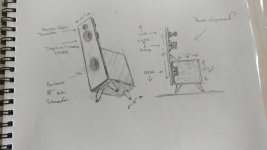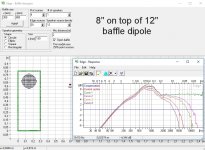Want to try and get this open baffle in FAST configuration with a subwoofer started and done. I've been putting this off forever. Here's the idea in sketch form attached.
The Open baffle part is Stephens Trusonic FR80 with an old Foster horn tweeter.
The frequency of 150hz to 5k is handled by the Stephens and from 5k on up is by the Foster.
From 150hz down will be done by a Peerless by Tymphany 830667 8" Paper Cone SLS Subwoofer
One of my questions is about the baffle size: Can I get away with 12" wide baffle for the Stephens mid/woofer to get down to 150hz? I like the idea of the narrow baffle to avoid diffraction.
Any help would be much appreciated.
The Open baffle part is Stephens Trusonic FR80 with an old Foster horn tweeter.
The frequency of 150hz to 5k is handled by the Stephens and from 5k on up is by the Foster.
From 150hz down will be done by a Peerless by Tymphany 830667 8" Paper Cone SLS Subwoofer
One of my questions is about the baffle size: Can I get away with 12" wide baffle for the Stephens mid/woofer to get down to 150hz? I like the idea of the narrow baffle to avoid diffraction.
Any help would be much appreciated.
Attachments
Last edited:
The off axis response will be better if you put the FR80 driver right at the top of the baffle. The tweeter can go below it.
Have you estimated the response curve and loss from the OB to check to see how low in frequency you can operate the driver given the input power and desired SPL? You may need to cross over to the Peerless a bit higher.
Otherwise, the design and crossover points look good. I would not worry about the phase alignment with this system, at least at this point in the design.
Have you estimated the response curve and loss from the OB to check to see how low in frequency you can operate the driver given the input power and desired SPL? You may need to cross over to the Peerless a bit higher.
Otherwise, the design and crossover points look good. I would not worry about the phase alignment with this system, at least at this point in the design.
The off axis response will be better if you put the FR80 driver right at the top of the baffle. The tweeter can go below it.
Have you estimated the response curve and loss from the OB to check to see how low in frequency you can operate the driver given the input power and desired SPL? You may need to cross over to the Peerless a bit higher.
Otherwise, the design and crossover points look good. I would not worry about the phase alignment with this system, at least at this point in the design.
Thanks for the help! Here's some info on the Stephens Trusonic 80FR - CLIPX Audio
It's rated FS is 40hz. At 125hz to 150hz the spl is at around 92ish. I will be biamping the subwoofer because this allows me to get the most versatile woofer.
The original Stephens Trusonic horn tweeter was crossed at 5k on their commercial offerings so I figured that would be a good place to start. I will crossover with a high pass second order.
I agree with Charlie - the midrange will get stressed below 300Hz because of dipole loss. It also beams quite a lot above 2kHz, so crossing around 3-4kHz might be better for overall sound.
How do you handle crossovers? There is a possibility that you might succeed without dsp if you let the woofer to play rather high. The Trusonic has high sensitivity in upper region, which on the other hand makes it harder to get working as dipole.
How do you handle crossovers? There is a possibility that you might succeed without dsp if you let the woofer to play rather high. The Trusonic has high sensitivity in upper region, which on the other hand makes it harder to get working as dipole.
Attachments
If you look at the plot Juhazi supplied you can see that:
*there is a peak or peaks in the response resulting from the open baffle loading iteself
*the SPL at the peak(s) is about +3dB above the reference level, which is the green horizontal line at higher frequency
*The curves are a downsloping towards lower frequency. These are the dipole losses.
*To guesstimate the system SPL for this driver you add this curve with the free air response of the driver
The driver's own response will drop the low end (below 200Hz or so) even more. This is where you need to cross to the woofer (not lower).
The classic OB passive crossover uses a first order low pass filter (e.g. a series inductor) that kicks in at about the low end of the passband for this driver, e.g. 200-300Hz. The filter rolls off the input power at 6dB per octave, and when you combine this with a rising response of 6dB per octave you get a flat response. That is until you get to the dipole peak - then there is a sudden downturn just above the peak. In this case that will happen around 1.5kHz. That won't work well here because you need to use the driver higher than that since (likely) your tweeter will not operate that low and you want to have dipole operation up to at least 3k, 5k is better.
You could try some kind of passive EQ/dip that just knocks down the dipole peak, but you still need to implement crossovers to W and T... Honestly dipole systems are much less flat than boxed systems and the EQ/contouring of the response is more complicated. DSP can be very useful for these systems. You could even do a hybrid with passive and DSP if it is important to implement things passively as much as possible. Of course DSP is an active approach that requires more channels of amplification (often one per driver).
To give you another system to compare to, I am currently building a 3-way dipole. This has an Eminence Alpha 15A in an H-frame much like the one MJ King wrote about back in 2008. It can operate up to about 275Hz. Next up is a 10" pro driver with extended high end response that I will use nude from 275Hz to about 2kHz. Then I use a dipole tweeter above that. In this case I can get away with a 10" nude because it (A) has high sensitivity (96dB/W) and enough cone area and Xmax to easily play loudly down to 300Hz.
Your Trusonic driver has high SPL, but not at low frequencies where you need it. There it is only about 92-93dB judging from the plot on the page you linked to. Xmax is likely low, however. It's all fine as long as you do not expect to operate the driver low in frequency, and can accommodate for the dipole response properly. Keep in mind that if you do this passively, all you can do is cut power to different frequencies. In dipole systems this often ends up knocking down the effective system sensitivity by 6dB or more. Active system can boost power to fill in "response holes" and when the response is complicated that can really be useful, and you don't need to "throw away" power like with the passive approach.
*there is a peak or peaks in the response resulting from the open baffle loading iteself
*the SPL at the peak(s) is about +3dB above the reference level, which is the green horizontal line at higher frequency
*The curves are a downsloping towards lower frequency. These are the dipole losses.
*To guesstimate the system SPL for this driver you add this curve with the free air response of the driver
The driver's own response will drop the low end (below 200Hz or so) even more. This is where you need to cross to the woofer (not lower).
The classic OB passive crossover uses a first order low pass filter (e.g. a series inductor) that kicks in at about the low end of the passband for this driver, e.g. 200-300Hz. The filter rolls off the input power at 6dB per octave, and when you combine this with a rising response of 6dB per octave you get a flat response. That is until you get to the dipole peak - then there is a sudden downturn just above the peak. In this case that will happen around 1.5kHz. That won't work well here because you need to use the driver higher than that since (likely) your tweeter will not operate that low and you want to have dipole operation up to at least 3k, 5k is better.
You could try some kind of passive EQ/dip that just knocks down the dipole peak, but you still need to implement crossovers to W and T... Honestly dipole systems are much less flat than boxed systems and the EQ/contouring of the response is more complicated. DSP can be very useful for these systems. You could even do a hybrid with passive and DSP if it is important to implement things passively as much as possible. Of course DSP is an active approach that requires more channels of amplification (often one per driver).
To give you another system to compare to, I am currently building a 3-way dipole. This has an Eminence Alpha 15A in an H-frame much like the one MJ King wrote about back in 2008. It can operate up to about 275Hz. Next up is a 10" pro driver with extended high end response that I will use nude from 275Hz to about 2kHz. Then I use a dipole tweeter above that. In this case I can get away with a 10" nude because it (A) has high sensitivity (96dB/W) and enough cone area and Xmax to easily play loudly down to 300Hz.
Your Trusonic driver has high SPL, but not at low frequencies where you need it. There it is only about 92-93dB judging from the plot on the page you linked to. Xmax is likely low, however. It's all fine as long as you do not expect to operate the driver low in frequency, and can accommodate for the dipole response properly. Keep in mind that if you do this passively, all you can do is cut power to different frequencies. In dipole systems this often ends up knocking down the effective system sensitivity by 6dB or more. Active system can boost power to fill in "response holes" and when the response is complicated that can really be useful, and you don't need to "throw away" power like with the passive approach.
- Status
- This old topic is closed. If you want to reopen this topic, contact a moderator using the "Report Post" button.

